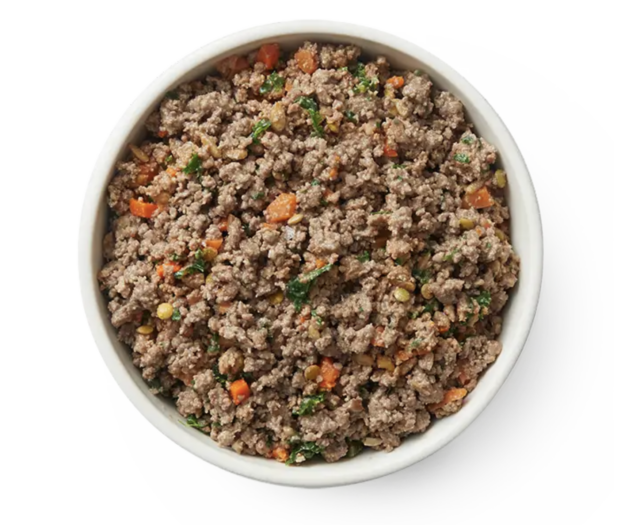iHeartDogs is reader-supported. When you buy via links on our site, we may earn an affiliate commission at no extra cost to you.
Diabetes in dogs is more common than many pet parents realize, affecting approximately 1% of the canine population. While this condition isn’t curable, it can be effectively managed with the right care, allowing dogs to live long, happy lives. Recognizing the early signs of diabetes—such as excessive thirst, frequent urination, and unexplained weight loss—is crucial for getting your pup the treatment they need.
If you suspect your dog may have diabetes, consulting your veterinarian is essential for a proper diagnosis and care plan. With the right combination of medication, diet, and lifestyle adjustments, diabetic dogs can thrive. In this guide, we’ll cover the key symptoms, treatment options, and the best diets to help manage diabetes in dogs, ensuring they stay as healthy and active as possible.
What is Diabetes in Dogs?
Diabetes mellitus is when your dog’s pancreas cannot regulate blood sugar properly. One of the pancreas’ jobs is to produce insulin to regulate the amount of glucose (sugar) in your pup’s bloodstream. Glucose provides energy for your dog’s cells, so without the right amount in your dog’s body, your dog can suffer from severe symptoms.
Dogs with diabetes don’t have enough insulin to control glucose levels, causing unnaturally high amounts of sugar in the bloodstream (a condition known as hyperglycemia.) If the glucose levels get too high, it may overflow into your dog’s urine as a condition known as glucosuria, causing your dog to drink and urinate more than normal.
Overall, diabetes causes a dog’s body to not function normally, which is why it can be dangerous or even life-threatening. Getting your dog on a proper treatment plan is essential to help their body function as normal as possible.

Types of Diabetes in Dogs
Like humans, dogs can be diagnosed with Type I, Type II, or Type III diabetes. Here’s what those types mean.
- Type I – Occurs when the body cannot produce enough insulin. This is the most common type for dogs.
- Type II – When the body cannot respond properly to the insulin created by the pancreas. Thus, less glucose enters the cells and more is left in the bloodstream. This is uncommon in dogs.
- Type III – Occurs when the body resists insulin because of other hormones like pregnancy hormones or tumors. This type is rare in dogs, but it can be life-threatening if it occurs.
Even though most dogs with diabetes have type I, it’s important for a vet to verify which type your pup has because it can affect how the condition is managed.
What Causes Diabetes in Dogs?
There’s no one cause for canine diabetes. Any dog can get it regardless of their age, breed, and health. However, some dogs are at a higher risk of diabetes, such as unspayed females, seniors, obese dogs, dogs with Cushing’s disease, or dogs with pancreatitis.
What Dogs Are the Most At Risk?
Dogs of any breed and age can get diabetes. However, it’s more common in adult and senior dogs than puppies. The average age for a dog to get diagnosed with diabetes is 7 to 10 years old.
While any dog breeds can get diabetes, the following are at a higher risk:
- Schnauzers (Miniature and Standard)
- Poodles (Miniature and Toy)
- Beagles
- Dachshunds
- Golden Retrievers
- Labrador Retrievers
- Samoyeds
- Keeshonds
- Alaskan Malamutes
- Cocker Spaniels
- Terriers (including Yorkshire Terriers and Cairn Terriers)
- Bichon Frises

Diabetes in Dogs: Symptoms
While diabetes doesn’t affect every dog the same, there are a few common symptoms, such as the following:
- Increased urination
- Excessive water drinking
- Increased appetite
- Weight loss
- Cloudy eyes
- Recurring infections
If your dog is experiencing any of the above symptoms, talk to your vet right away. It’s best to catch diabetes early on so you can start your dog on a treatment regimen.
Diabetes in Dogs Life Expectancy
The lifespan of a dog with diabetes varies greatly depending on the dog’s health and the severity of their diabetes. Without treatment, dogs may only live one to two months after their diagnosis. However, dogs getting treated for diabetes can live a fairly normal life, living for years after their diagnosis.
Diabetes in Dogs Treatment
In addition to observing symptoms, vets can diagnose diabetes if they notice high levels of glucose in your dog’s blood or glucose in their urine. Diabetes is the only common disease in canines that causes glucose levels in the blood to rise drastically. Unfortunately, there’s no treatment method that can make diabetes go away, but there are ways to effectively manage it.
Once a dog is diagnosed with diabetes, the main treatment method is insulin injections. Most dogs need twice-daily insulin injections. For many dog parents, the idea of administering injections sounds terrifying, but it’s only a small amount of insulin in a tiny needle, so most dogs won’t put up a fuss. A vet or vet tech can teach you how to properly administer the injections.
If you want to be able to easily monitor your diabetic dog’s health from home, your vet may be able to provide you with at-home blood and urine tests. That way, you can use a test when something seems wrong to determine if it’s an emergency. Have the number of your vet and an emergency vet saved in your phone so you can quickly contact a professional when needed.

Treating Dog Diabetes Without Insulin
Unfortunately, it’s rare to treat a diabetic dog without insulin shots. As daunting as it may seem, it’s usually the most effective way to keep your dog healthy and safe. Your vet can tell you if there are other treatment options, but never try a different type of treatment without a vet’s approval.
Even though insulin is necessary, there are other actions to pair with the injections. For example, you should choose a special diet for your dog with the help of your veterinarian. Most diabetic dogs benefit from high-fiber diets with specific levels of fat, protein, and carbohydrates for maintaining safe blood sugar levels. In some cases, the best food for your dog will need to be prescribed by a veterinarian. Here are some feeding tips for a diabetic dog.
Most veterinarians recommend getting female diabetic dogs spayed if they aren’t already. Diabetic dogs should also be getting proper exercise, so talk to your vet about an exercise routine for your dog.
What Happens if Canine Diabetes Isn’t Managed?
If you don’t take any steps to manage your dog’s diabetes, glucose floods the bloodstream and the cells that need it cannot properly access it. The dog’s body will no longer have the energy it requires, and your furry friend could face severe health concerns as a result, such as skin infections, urinary tract infections, eye problems, enlarged liver, kidney failure, seizures, or ketoacidosis. Thus, following your vet’s advice could save your dog’s life.
Can Diabetes in Dogs Be Prevented?
Unfortunately, there isn’t much that can be done to prevent diabetes in dogs. Spaying female dogs and keeping your dog a healthy weight can reduce the risk, but there’s still a chance that healthy, spayed dogs could get it. So, the best thing dog parents can do is take their dog in for regular vet checkups and alert their vet as soon as any unusual symptoms occur. Checkups every six months are recommended for diabetic dogs.

Best Food for Dogs with Diabetes
Before choosing food for a dog with diabetes, talk to your vet. Diabetes is a serious health concern that involves a special diet based on the individual dog’s needs. Your vet will be able to help you decide what food is safest for your furry friend. The following dog food brands are only a few suggestions for a diabetic dog, so if one looks interesting to you, ask your vet if it’s a good choice for your canine companion.
You may also want to consider specialized supplements and treats for dogs with diabetes, but again, you should choose those products with the help of your vet.
The Farmer’s Dog
The Farmer’s Dog can benefit a variety of dogs because it offers personalized fresh food. To get started, you’ll fill out a questionnaire about your dog’s age, breed, ideal weight, and health needs. Then, the company will pick a formula and portion that’s perfect for your diabetic dog, considering the ingredients they need and the weight they should be. The food is shipped right to your door, and every recipe includes fresh, human-grade ingredients. This food can help with your dog’s health while also being flavorful for picky eaters.
Sundays Food for Dogs
Sundays dog food includes human-grade ingredients that are gently air-dried to preserve flavor and nutrition. The formulas are vet-made and all-natural. Diabetic dogs may benefit from this diet because it’s high in fiber with prebiotics to aid healthy digestion. It also avoids unnecessary ingredients to reduce the risk of weight gain in dogs. The beneficial ingredients can aid your dog’s health in a variety of areas including their joints, skin, and coat. Even picky pups enjoy this unique pet food.
Hill’s Prescription Diet w/d Multi-Benefit Dry Dog Food
This is a prescription dog food option, so you need your vet’s recommendation to purchase it. It’s a specialized dog food formula that has moderately high levels of fiber to aid in digestion. It also helps dogs maintain a healthy weight and manage blood sugar, which are crucial for diabetic dogs. Some other benefits include promoting lean muscle mass, maintaining urinary tract health, and improving immune system health. This nutrition has been clinically tested, which is why it’s recommended by veterinarians for a variety of conditions.
iHeartDogs Customers Get 35% OFF Their First Auto Ship Order and FREE SHIPPING on Orders Over $50!
Frequently Asked Questions
What are the First Signs of Diabetes in Dogs?
The first signs of diabetes in dogs include increased thirst and urination, noticeable weight loss despite having a normal or increased appetite, and lethargy or decreased energy. These symptoms can develop gradually, so dog parents need to be attentive to any subtle changes in their pet’s behavior and physical condition.
Is Diabetes in Dogs Reversible?
Diabetes in dogs is generally not reversible and is a lifelong condition. However, early detection and proper management can help maintain a good quality of life for a diabetic dog.
What Diet is Best for a Diabetic Dog?
For diabetic dogs, a diet high in fiber and is often recommended, as it helps to slow the absorption of glucose and maintain more stable blood sugar levels. It’s also important to manage the dog’s weight and portion sizes. Specific dietary recommendations can vary, so it’s best to consult with a veterinarian for a tailored diet plan that suits the individual needs of the diabetic dog.
What Food Causes Diabetes in Dogs?
There is no specific food that directly causes diabetes in dogs, but a diet high in fats and simple carbohydrates, leading to obesity, can increase the risk of developing the disease. Consistently feeding dogs human foods, particularly those high in sugar, can also contribute to the development of obesity and potentially diabetes. It’s important to maintain a balanced and appropriate diet for dogs to minimize these risks.
Is Diabetes in Dogs the Same as in Humans?
Diabetes in dogs is similar to human diabetes in that it involves the inability to properly regulate blood sugar levels, but there are differences in the types and management. Most dogs suffer from insulin-dependent diabetes (similar to Type 1 in humans), requiring lifelong insulin therapy. The specific care and treatment protocols can vary between dogs and humans, reflecting differences in physiology and disease progression.

Helping Your Dog Thrive with Proper Diabetes Management
Managing diabetes in dogs may seem overwhelming at first, but with the right care, your pup can still enjoy a long, happy, and active life. Early detection, consistent treatment, and a well-balanced diet are key to keeping their blood sugar levels stable and preventing complications.
By working closely with your veterinarian and making necessary lifestyle adjustments, you can ensure your dog stays as healthy as possible. With love, patience, and the right management plan, diabetic dogs can continue to thrive—because every dog deserves a life full of tail wags and joy!



 Toledo, United States.
Toledo, United States.